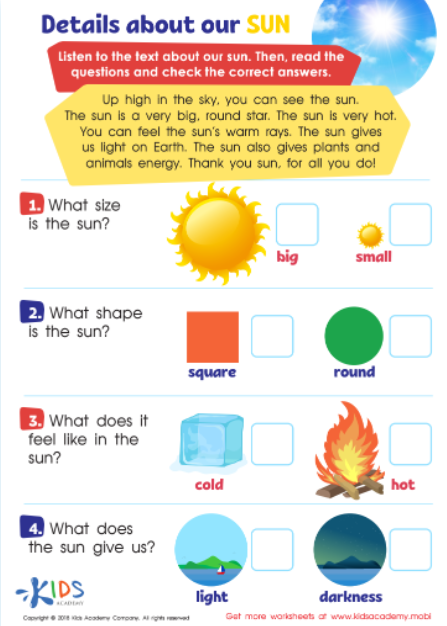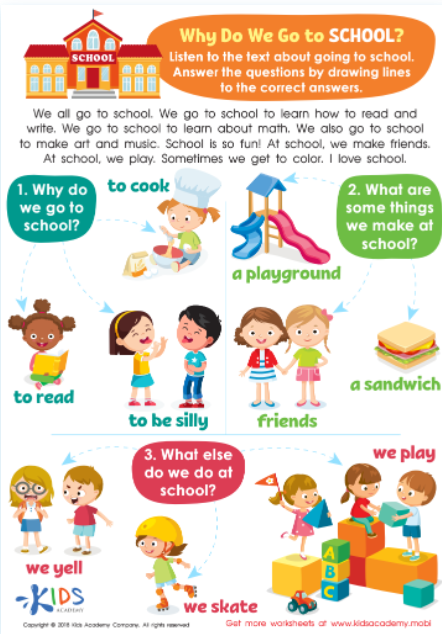-
English
-
English Pre-K
-
Unit 1: Early Literacy Skills
-
ABCs
- Pre-writing Activities
- Letter A
- Letter B
- Letter C
- Letter D
- Letter E
- Letter F
- Letter G
- Letter H
- Letter I
- Letter J
- Letter K
- Letter L
- Letter M
- Letter N
- Letter O
- Letter P
- Letter Q
- Letter R
- Letter S
- Letter T
- Letter U
- Letter V
- Letter W
- Letter X
- Letter Y
- Letter Z
-
Phonological Awareness
- Rhyming Words
- Letter Sounds B, C, D, and F
- Letter Sounds G, H, J, and K
- Letter Sounds L, M, N, and P
- Letter Sounds Q, R, S, and T
- Letter Sounds V, W, X, Y, and Z
- Letter Sounds A, E, and I
- Letter Sounds O and U
- Beginning Sounds
- Matching Letters to Sounds
-
ABCs
-
Unit 2: Vocabulary
-
Common Words
- Sorting Words into Categories
- Color Words
- Verbs and Adjectives
-
Sight Words
- Sight Words 'I' and 'Can'
- Sight Words 'You' and 'Like'
-
Common Words
-
Unit 3: Print Awareness
-
Parts of a Book
- Working with a Book
- Spaces Between Words
- Text and Illustrations
-
Picture Books and Poems
- Picture Book Text Features
- Poem Text Features
- Signs and Labels in the Community
-
Parts of a Book
-
Unit 4: Reading Literature
- Questions About Stories
- Discussing Stories
-
Unit 5: Reading Informational Texts
- Retelling Details in a Text
- Questions About a Text
- Connections Between Events
- Text Features
- Describing Illustrations
-
Unit 1: Early Literacy Skills
-
English Pre-K
-
Math
-
Math for Pre-Kindergarten
-
Logic and Geometry
-
Matching and Sorting
- Same and Different
- Which One Is a Little Different?
- Objects That Go Together
- Sorting by Color and Size
- Sorting The Same Group in Different Ways
- Patterns
-
Shapes
- Shapes in Our Environment
- Naming Shapes Regardless of Size
- Making Shapes in Preschool
- Comparing Shapes
- Relative Positions
- Sorting Shapes
-
Matching and Sorting
-
Early Number Sense
-
Numbers 1–5
- Counting to 3
- Counting to 5
- Arranging Objects up to 3 Objects
- Arranging up to 5 Objects
- Writing Numbers 1–5
-
Numbers 1–5
-
Numbers up to 10
- Counting to 10
- Arranging up to 10 Objects
- Number 0
- Writing Numbers 6–10
- Breaking Down Numbers 6-10
-
Logic and Geometry
-
Math for Pre-Kindergarten
The Questioning Strategy Nonfiction Texts
Why is the sky blue? Who invented tacos? What would happen if I didn’t have a belly button? Most Pre-K students bubble with curiosity as they make connections at every turn.
Nonfiction texts are great to use with students of all ages. Questioning is a critical reading skill that helps with comprehension monitoring. These questions should be asked before, during, and after reading.

The Benefits of Questioning
How does asking questions help us understand a text? The purpose of reading is to construct meaning. Good readers monitor their understanding as they read. Questioning is one of the first comprehension strategies to introduce to your child. (Harvey, 2000)
Many readers have an inner dialogue as they read to keep track of new learning. In a nonfiction text, your child may encounter unfamiliar concepts. Perhaps they don’t know what a word means.
When this occurs, we want our young readers to notice. Before they are old enough to write, we can have them verbalize these questions as they come up.
Your Child’s Questions Are Important
While reading a nonfiction text aloud, stop to ask you what questions he has about that section of the text. Consider writing the questions down to keep track. Sometimes the questions are answered right in the text. In other cases, your child may need to conduct further research to find answers.
The Best Questions to Ask About an Informational Text

Before, During, and After Reading Questions
Parents can ask questions to guide the discussion of a nonfiction text. Strive to ask questions before, during, and after reading.
Before Reading Questions:
- What do you think this text will be about?
- What do you already know about this topic?
- What do you see in the pictures?
During Reading:
- What does __________ mean?
- What happened in this paragraph?
- Can you describe how __________?
After Reading:
- What is the main topic of the text?
- How do the photographs help you understand?
- Does this new information remind you of something you already know?
Higher Level Questions
It's not too early to expose your child to rigorous questions that challenge critical thinking skills. Open-ended questions lead to rich discussions and encourage further research.
Your child might clam up in fear of taking a risk and answering a question incorrectly. These formative years are the best time to develop a growth mindset. If your child isn't sure how to answer, ask for their best guest. Then, model how to find the answer.
Try These Instructional Strategies
KWL Chart
A KWL chart can be completed collectively or independently. Here is an example:
K What I Know About a Topic | W What I Want to Know | L What I Learned |
3-2-1 Strategy
Pre-K students are not ready to write a summary yet, but this is a great stepping stone towards that skill.
List 3 new faces you learned.
Ask 2 questions about your new learning.
Make 1 personal connection to the information.
The 5 W’s (Who, What, When, Where, Why)
Who is the main character?
What did you learn about the topic?
When did these events take place?
Where did these events take place?
Why did these actions take place?
The bottom line is that inquiry lights the path to understanding. Provide your child with opportunities to ask questions while reading. Take advantage of the research-based materials available through Kids Academy to get started today.
By: Monica Edwards
English Language Arts Teacher, Curriculum Writer
Sources:
Harvey, S., & Goudvis, A. (2007). Strategies that work: Teaching comprehension for understanding and engagement. Portland, Me: Stenhouse Publishers.

